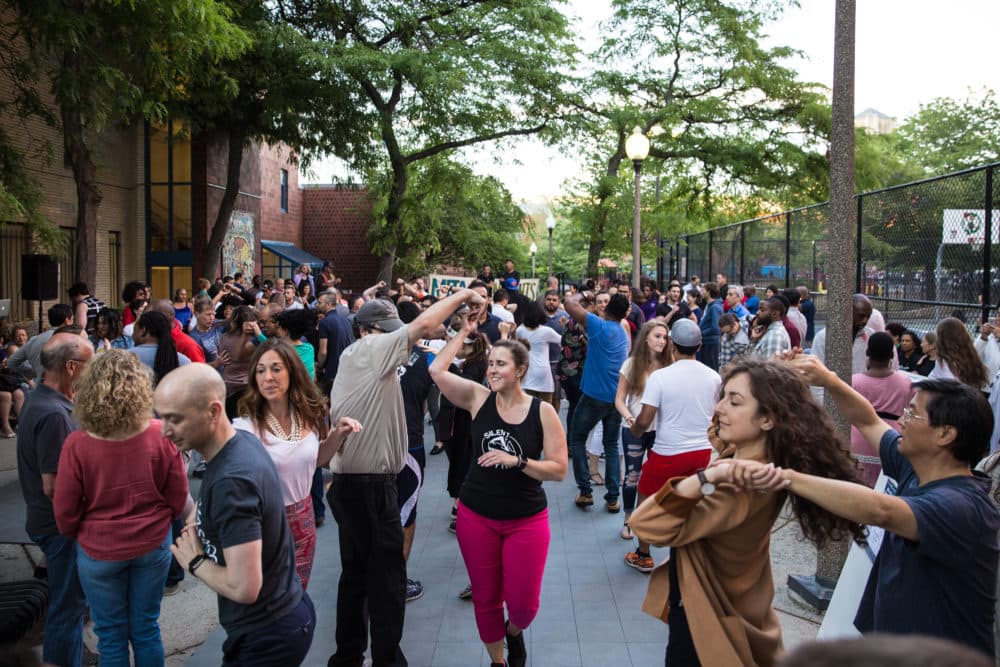Advertisement
NEFA And Barr Foundation Reveal Results Of Creative City Grant Program, Increase Award Amounts

Since 2015, Creative City, a pilot grant program by the Barr Foundation and New England Foundation for the Arts, has funded nearly four dozen innovative art projects, allowing Boston artists to turn their neighborhoods into public art studios and marking a systemic increase in arts funding.
The premise behind the pilot program was to give artists the opportunity to take risks with their artwork.
The grant allowed artists Elisa H. Hamilton and Silvia Lopez Chavez to create a “lemonade stand” art installation outside the Franklin Hill Boys and Girls Club. They built a neon yellow kiosk and asked members of the public to share stories of overcoming and to reflect on moments when they “turned lemons into lemonade.”
The money also allowed longtime Boston artist Wen-ti Tsen to bring historical photographs of Chinatown’s first immigrants provided by the Chinese Historical Society of New England to life, painting them as large scale, life-sized portraits in vibrant color and mounting them on wooden boards around Chinatown. These figures gave passersby insight into the history of the nation’s third-largest Chinatown and offered a way to open up discussions about the effects of gentrification.
This grant also allowed artist Ifé Franklin to build the homes of her enslaved ancestors as a way to honor them with her Indigo Project. She said the idea for this community installation in Roxbury literally came to her in a dream. Inside these structures, which were designed to look like slave cabins, she taught participants to make fabric using a traditional West African method meant to celebrate the resilience of their ancestors. Outside she invited the community to dance, heal and celebrate together through ritual. The Creative City grant was the first Franklin had ever received, despite the fact that she’s been a professional artist for more than 25 years.
The grant has awarded $445,000 to artists over five round of applications along with $46,000 to 46 community organizations that supported the artist's works.
Now, the foundations plan to launch Creative City Boston, a new grant inspired by the pilot program, that will infuse $950,000 provided by the Barr for artists in Boston neighborhoods. The call for concept proposals for the next round of funding will begin this month. The foundations are increasing the awards for lead artists from up to $10,000 to up to $20,000. They're also upping the amount of money given to community partners from $1,000 to $5,000.
Advertisement
NEFA and Barr made a concerted effort to reach communities who have been historically excluded, resulting in more applicants of color as well as diverse forms of artistic expression. Creative City provided communications, public relations, and photography to promote artist's projects.
Each years’ grantees become part of a cohort that receive professional development as well as networking opportunities. Kim Szeto, program director of public art at NEFA, said she was struck by the bonds between the artists and the support they gave each other as they began their projects.
“Creative City set out to fund a diverse pool of artists, bringing together artists of various disciplines at various stages in their career,” Szeto said. “In our first cohort, we had Wen-ti Tsen who's been creating public art here in Boston for over 60 years. And then later on in the program we supported Ngọc-Trân Vũ who is a young artist working in Dorchester and through Creative City we saw this partnership and mentorship grow between Wen-ti and Tran.”
The Creative City pilot has funded more than 60 lead artists, funding and supporting 46 projects through this initial pilot. Grants ranged between $2,500 to $10,000 and include 13 visual arts projects, 20 performing arts projects, two literary projects, two media arts projects and nine interdisciplinary projects.
“I think that it was about ensuring that artists had the capital that they needed to really lift up voices in neighborhoods around Boston,” said San San Wong, the director of arts & creativity at the Barr Foundation, “to really disrupt kind of the public imagination, re-imagined places, redefine who owned them, and to be able to engage residents in creating a future Boston that was more owned by many people and many diverse cultures.”
Officials said an estimated 47 percent of applicants self-identified as people of color, while 67 percent of creative city grantees self-identified as people of color.
Cathy Edwards, the executive director of NEFA, said this has been an important time to invest in Boston arts. “Data we have shows that a significant portion of New England's creative workforce is based in Massachusetts and in Boston. Half of the jobs in New England's creative economy are in Massachusetts. So we wanted to invest in the talent that's here in Boston.”
